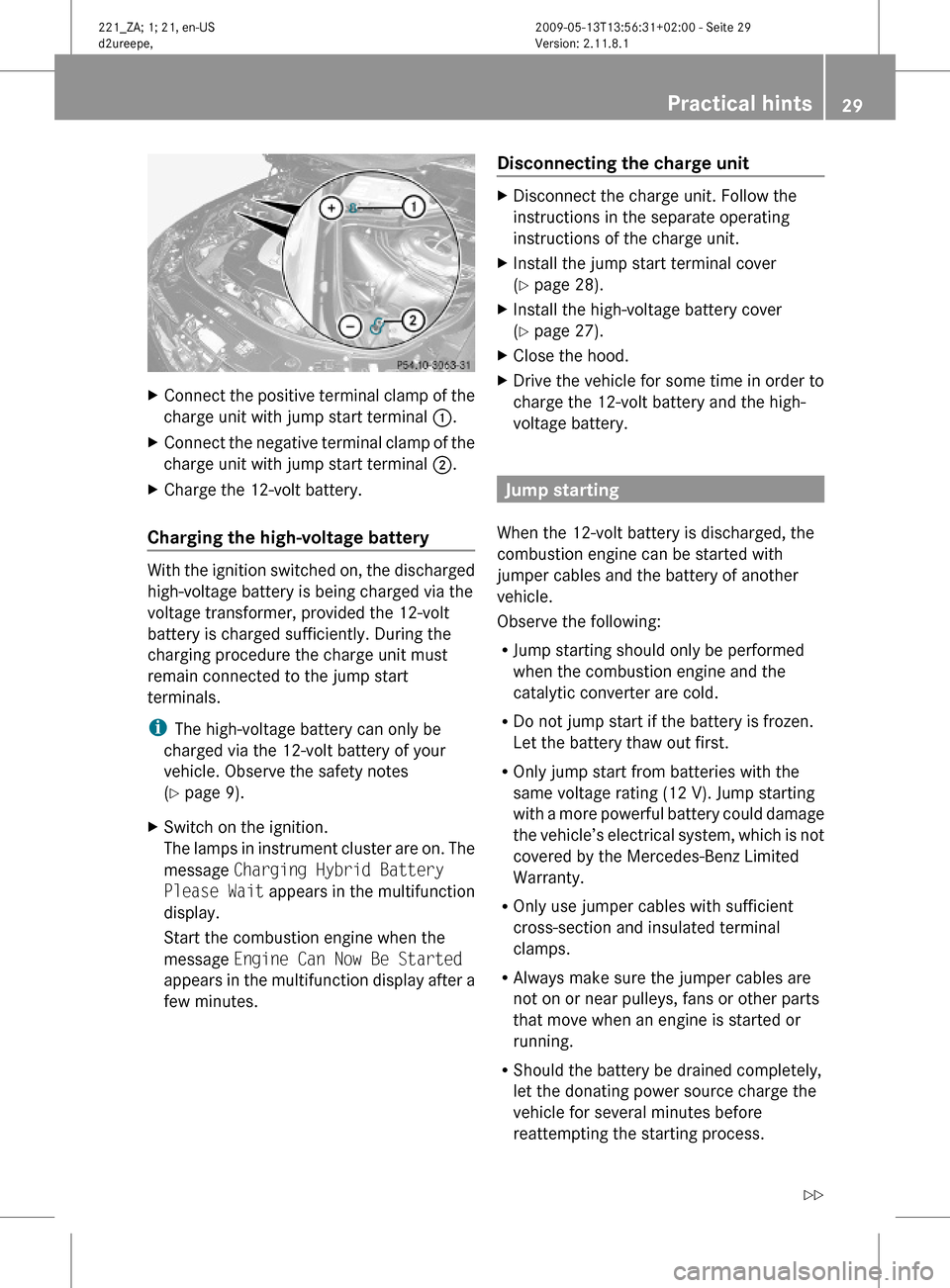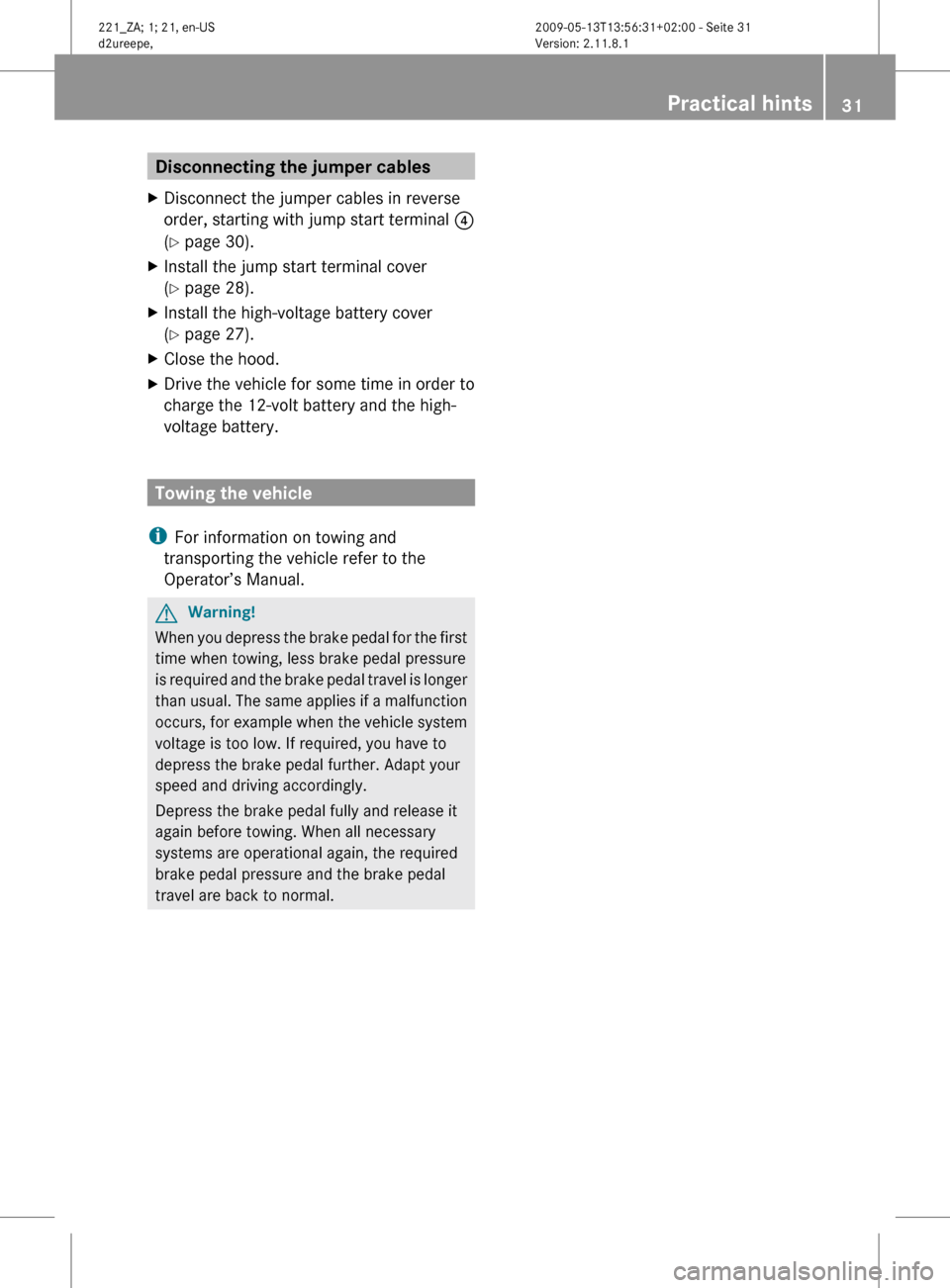Page 31 of 40

XConnect the positive terminal clamp of the
charge unit with jump start terminal 1.
XConnect the negative terminal clamp of the
charge unit with jump start terminal 2.
XCharge the 12-volt battery.
Charging the high-voltage battery
With the ignition switched on, the discharged
high-voltage battery is being charged via the
voltage transformer, provided the 12-volt
battery is charged sufficiently. During the
charging procedure the charge unit must
remain connected to the jump start
terminals.
iThe high-voltage battery can only be
charged via the 12-volt battery of your
vehicle. Observe the safety notes
(Y page 9).
XSwitch on the ignition.
The lamps in instrument cluster are on. The
message Charging Hybrid Battery
Please Wait appears in the multifunction
display.
Start the combustion engine when the
message Engine Can Now Be Started
appears in the multifunction display after a
few minutes.
Disconnecting the charge unitXDisconnect the charge unit. Follow the
instructions in the separate operating
instructions of the charge unit.
XInstall the jump start terminal cover
(Y page 28).
XInstall the high-voltage battery cover
(Y page 27).
XClose the hood.XDrive the vehicle for some time in order to
charge the 12-volt battery and the high-
voltage battery.
Jump starting
When the 12-volt battery is discharged, the
combustion engine can be started with
jumper cables and the battery of another
vehicle.
Observe the following:
RJump starting should only be performed
when the combustion engine and the
catalytic converter are cold.
RDo not jump start if the battery is frozen.
Let the battery thaw out first.
ROnly jump start from batteries with the
same voltage rating (12 V). Jump starting
with a more powerful battery could damage
the vehicle’s electrical system, which is not
covered by the Mercedes-Benz Limited
Warranty.
ROnly use jumper cables with sufficient
cross-section and insulated terminal
clamps.
RAlways make sure the jumper cables are
not on or near pulleys, fans or other parts
that move when an engine is started or
running.
RShould the battery be drained completely,
let the donating power source charge the
vehicle for several minutes before
reattempting the starting process.
Practical hints29221_ZA; 1; 21, en-USd2ureepe,Version: 2.11.8.12009-05-13T13:56:31+02:00 - Seite 29Z
Page 32 of 40

iJumper cables and additional information
on jump starting are available at any
authorized Mercedes-Benz Center.
! Jump starting should only be performed
using the jump-start terminals located in
the engine compartment.
Avoid repeated and lengthy starting
attempts.
Do not attempt to start the engine using a
battery quick-charge unit.
If the engine does not run after several
unsuccessful starting attempts, have it
checked at the nearest authorized
Mercedes-Benz Center.
Excessive unburned fuel generated by
repeated failed starting attempts may
damage the catalytic converter and may
present a fire risk.
Make sure the jumper cables do not have
loose or missing insulation.
Make sure the cable clamps do not touch
any other metal part while the other end is
still attached to a battery.
Connecting the jumper cables
XMake sure the two vehicles do not touch.XRemove the high-voltage battery cover
(Y page 27).
XRemove the jump start terminal cover
(Y page 28).
Your vehicle is equipped with two jump start
terminals in the engine compartment.
XConnect jump start terminal = with
positive terminal ; of the external battery
with a jumper cable. Clamp the jumper
cable to jump start terminal 3 first.
XConnect negative terminal 1 of the
external battery with jump start terminal
4 with a jumper cable. Clamp the jumper
cable to negative terminal 1 of the
external battery first.
Starting the combustion engine
XStart the engine of the vehicle with the
charged battery and run it at an engine
speed slightly above idle speed.
XSwitch on the ignition of your vehicle.
The lamps in the instrument cluster come
on. Wait to start the combustion engine, if
the message Charging Hybrid Battery
Please Wait appears in the multifunction
display.
Start the combustion engine only after the
message Engine Can Now Be Started
has appeared in the multifunction display.
This may take a few minutes.
If no messages appear in the
multifunctional display, you can start the
combustion engine directly.
XAfter the combustion engine of your vehicle
has been started, leave the engines of both
vehicles running at idle speed.
30Practical hints221_ZA; 1; 21, en-USd2ureepe,Version: 2.11.8.12009-05-13T13:56:31+02:00 - Seite 30
Page 33 of 40

Disconnecting the jumper cablesXDisconnect the jumper cables in reverse
order, starting with jump start terminal 4
( Y page 30).XInstall the jump start terminal cover
( Y page 28).XInstall the high-voltage battery cover
( Y page 27).XClose the hood.XDrive the vehicle for some time in order to
charge the 12-volt battery and the high-
voltage battery.
Towing the vehicle
i For information on towing and
transporting the vehicle refer to the
Operator’s Manual.
GWarning!
When you depress the brake pedal for the first
time when towing, less brake pedal pressure
is required and the brake pedal travel is longer
than usual. The same applies if a malfunction
occurs, for example when the vehicle system
voltage is too low. If required, you have to
depress the brake pedal further. Adapt your
speed and driving accordingly.
Depress the brake pedal fully and release it
again before towing. When all necessary
systems are operational again, the required
brake pedal pressure and the brake pedal
travel are back to normal.
Practical hints31221_ZA; 1; 21, en-USd2ureepe,Version: 2.11.8.12009-05-13T13:56:31+02:00 - Seite 31Z
Page 34 of 40

Identification labels
i For more information on the identification
labels, refer to the Operator’s Manual.
Electric drive
The engine number is engraved on the
housing of the electric drive. For more
information contact an authorized Mercedes-
Benz Center.
Vehicle specification S 400 HYBRID
(221.195)
The quoted data apply only to the standard
vehicle. Contact an authorized Mercedes-
Benz Center for the corresponding data of all
special bodies and special equipment.
Engine S 400 HYBRIDEngine, type272Mode of operation4-stroke engine,
gasoline injectionNo. of cylinders6Bore3.66 in (92.90 mm)Stroke3.39 in (86.00 mm)Total piston
displacement213.5 cu in
(3 498 cm 3
)Compression
ratio11.7:1Output acc. to
SAE J 1349 1275 hp/6
000 rpm
(205 kW/6 000 rpm)Maximum torque
acc. to SAE J 1349258 lb-ft/
3 000 - 5 500
(350 Nm/
3 000 - 5 500 rpm)Engine S 400 HYBRIDMaximum engine
speed6 500 rpmFiring order1-4-3-6-2-5Poly-V-belt2 404 mmElectric drive S 400 HYBRIDTypePermanent-field
synchronous motorOutput20 hp (15 kW)Maximum
starting torque160 NmElectrical system S 400 HYBRIDAlternator14 V/180 ABattery12 V/95 AhSpark plugs, typeBosch Y 7 MPP33Spark plugs,
electrode gap0.031 in (0.8 mm)Spark plugs,
tightening torque15 - 18 lb-ft
(20 - 25 Nm)Main dimensions S 400 HYBRIDOverall vehicle
length206.7 in (5 250 mm)Overall vehicle
width 283.5 in (2
120 mm)Overall vehicle
height58.2 in (1 479 mm)Wheelbase124.6 in (3 165 mm)Track, front63.0 in (1 600 mm)1
Premium fuel required. Performance may vary with fuel octane rating.
2 Exterior rear view mirrors folded out.32Technical data221_ZA; 1; 21, en-USd2ureepe,Version: 2.11.8.12009-05-13T13:56:31+02:00 - Seite 32
Page:
< prev 1-8 9-16 17-24